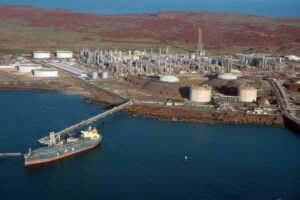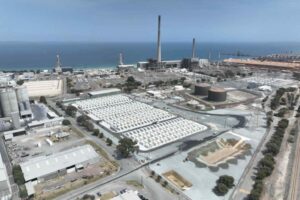It’s always a nervous moment when, logging onto Twitter on Sunday morning Europe time, my notifications are filled with the #Insiders hashtag. It means someone has been on there talking about climate, energy or both, and it means watching it back and picking through the pieces.
Refreshingly, David Speers’ interview with Australia’s Prime Minister Scott Morrison was nicely done; interrogating the numerous holes in the government’s recent strange and clumsily-patched-together pro-gas energy policies. The questioning revealed some very, very important things about Australia’s climate policy. Let’s dive in..
Net zero by ……. 2300?
A commonly held misconception (including by myself, until very recently) is that the Paris climate change agreement requires signatories to reach net zero emissions by the year 2050. This is not quite what the wording suggests, which reads that the goal is to “achieve a balance between anthropogenic emissions by sources and removals by sinks of greenhouse gases in the second half of this century”.
In the second half of the century – not by. Of course, reaching net zero by the year 2100 is badly insufficient. To keep the planet limited to a 1.5°C target, net zero CO2 emissions needs to be reached by 2050, and net zero GHG emissions by 2063 to 2068. For a 2°C target, it’s 2070 to 2085 for CO2, and the end of the century for all GHG. Of course, the difference between 1.5° and 2° sounds small, but bringing emissions down to zero by 2050 or sooner is vital to avoid some horrific impacts on human life.
This flew past quickly in the interview, but it was incredibly significant. Morrison said, of net zero emissions:
“Well, as you know, our policy is to achieve that in the second half of this century, and I certainly will achieve that, and that’s why this week’s announcements were so important because it was about the technology we need to invest in now, which will make it a reality, particularly on the other side of 2030. The target that you’ve talked about becomes absolutely achievable. I’m interested in doing the things that make that happen. I think that is very achievable”
This was immediately mis-reported as Morrison declaring that net zero emissions by 2050 is “achievable”. It’s the by / in confusion. Morrison was, in fact, effectively stating that Australia would reach net zero emissions by 2100. Heck, what’s a half-century between friends?
In fact, Australia’s Paris climate agreement targets are neatly aligned with reaching net zero by 2100, whereas Labor’s old 45% by 2030 targets were aligned with net zero by 2050 (the far safer option). Unfortunately, the latest projections from the government are wildly off course, not only for net zero by 2050, but also for net zero by 2100:
If the rate of yearly emissions drops between 2020 and 2030 in Australia’s government projections continue, by my own reckoning, Australia will reach net zero emissions in the year 2300:  The green line above is the clearest explanation of why the government is shunning any ‘ratchet’ of its Paris ambition or any new binding targets, no matter whether it’s 2050 or 2100. Defending Australia’s fossil fuel industries from massive global change will need a mad scramble of government support right now – hence, the ‘gas-fired recovery’, to lock in as much new infrastructure as possible. The government sees the various pathways splitting out into the future, and it knows precisely which one it wants to be on. But how to realise that pathway?
The green line above is the clearest explanation of why the government is shunning any ‘ratchet’ of its Paris ambition or any new binding targets, no matter whether it’s 2050 or 2100. Defending Australia’s fossil fuel industries from massive global change will need a mad scramble of government support right now – hence, the ‘gas-fired recovery’, to lock in as much new infrastructure as possible. The government sees the various pathways splitting out into the future, and it knows precisely which one it wants to be on. But how to realise that pathway?
Gas chose itself
Morrison’s metadata moment arrived when Speers asked Morrison to explain why the government was threatening to build a 1,000 megawatt gas-fired power station, and why it had to be gas they were threatening to build. Morrison talked with a spiel about technology neutrality:
“You won’t get there, I guarantee you this, if you are going to narrow the sorts of technologies and the sorts of solutions that you are prepared to look at which is why we want to broaden that out”
Mere seconds later, Morrison was asked about why, then, he’d narrowed down his own choices and specified gas-fired generation as the ‘gap filler’ for the closure of NSW’s coal-fired power station Liddell. His reply was memorable:
“Gas has chosen itself, because as yet there has been nothing that has been presented which meets the goals that we have which is reliability and the firming capability for renewables to meet the gap that will be created”
It’s a lie, and an important one. Several years ago, AGL proposed a plan to replace Liddell’s capacity with a mixture of gas, wind and battery storage. A UTS study went a step further, proposing a fully zero emissions replacement, including demand-side response. Most recently, AEMO’s assessment found there was sufficient existing and proposed capacity to fully meet reliability requirements – no new machines needed at all. Morrison immediately began walking back the ‘1,000 megawatt’ figure, but confusingly insisted there was still a ‘250 megawatts’ gap, despite that also contradicting the market operator’s advice.
Will the government’s new gas-fired power station keep shrinking in size? Will it be 100 megawatts next week, and 10 the week after, until it finally reaches parity with the reality: that we should have precisely zero megawatts of new fossil fuels on the grid? The messages have been worse than mixed – they’ve been weird, confusing, contradictory and far from reassuring.
What it all means
When Morrison says ‘gas chose itself’, it makes perfect sense. There was never any doubt that those who most loudly profess to be ‘technology neutral’ are scrambling for a euphemistic way of dismissing the urgency of climate action. Liddell is the first long-forewarned coal shutdown on Australia’s grid, and the eye-opening mess that is unfolding before our eyes forecasts the same process of bluster and repetition of the word ‘reliability’, instead of simple, effective climate policy that allows planners, investors and communities to forge ahead. Gas is choosing itself: it is the only fossil fuel left that hasn’t lost 100% of its public support and investability. There is no other hydrocarbon left to choose, and the future pathway of continued fossil fuel reliance and ultra-high emissions is linked inextricably to the growth of fossil gas.
What we’re seeing here is the mechanics of Scott Morrison’s Three Hundred Year climate plan. This is how he intends to keep fossil fuels alive and kicking as long as humanly possible. Of course, Australia won’t take three hundred years to ditch fossil fuels. Australia will decarbonise in an orderly way, if we take the urgency of this seriously, or it will decarbonise in a horrific, chaotic and unpleasant way, if the transition is continually put off. But we’re talking about imaginations here, not the realities of physics, energy, society and humanity.
We are gazing at the target-less, pseudo-technocratic, inaction-by-distraction climate attitude from the eyes of the man in charge. Delaying this transition as much as possible is the endgame here, and what better way to do it than to take these moments of transition and change, and inject as much chaos, confusion and baffling weirdness into them as humanly possible.









